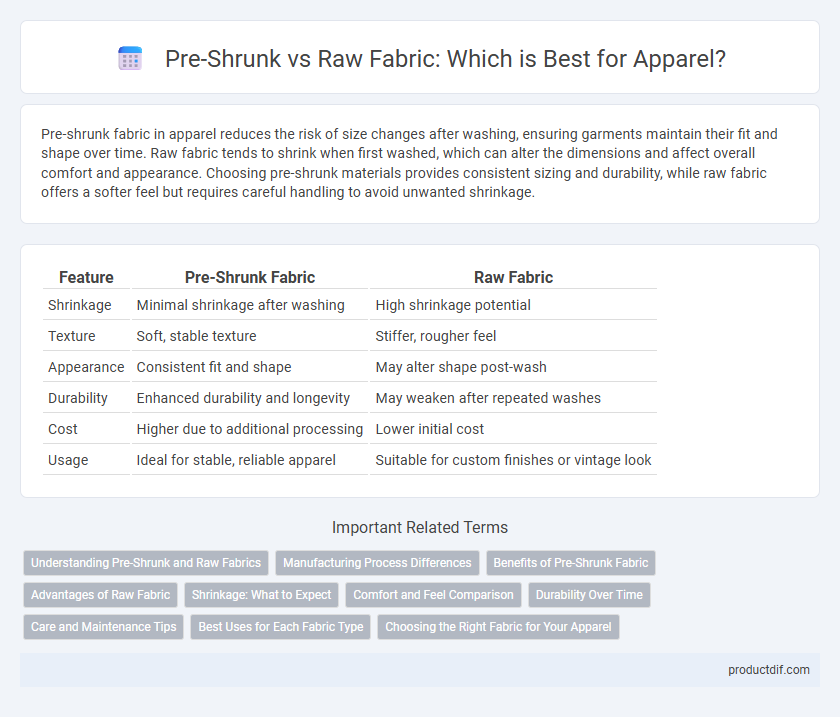Pre-shrunk fabric in apparel reduces the risk of size changes after washing, ensuring garments maintain their fit and shape over time. Raw fabric tends to shrink when first washed, which can alter the dimensions and affect overall comfort and appearance. Choosing pre-shrunk materials provides consistent sizing and durability, while raw fabric offers a softer feel but requires careful handling to avoid unwanted shrinkage.
Table of Comparison
| Feature | Pre-Shrunk Fabric | Raw Fabric |
|---|---|---|
| Shrinkage | Minimal shrinkage after washing | High shrinkage potential |
| Texture | Soft, stable texture | Stiffer, rougher feel |
| Appearance | Consistent fit and shape | May alter shape post-wash |
| Durability | Enhanced durability and longevity | May weaken after repeated washes |
| Cost | Higher due to additional processing | Lower initial cost |
| Usage | Ideal for stable, reliable apparel | Suitable for custom finishes or vintage look |
Understanding Pre-Shrunk and Raw Fabrics
Pre-shrunk fabric undergoes a controlled washing and drying process to minimize shrinkage after garment production, ensuring consistent fit and durability. Raw fabric, also known as unwashed or untreated fabric, retains its original fibers and texture but may shrink or change appearance after the first wash. Understanding these differences helps consumers choose garments based on desired fit stability, fabric feel, and long-term wear characteristics.
Manufacturing Process Differences
Pre-shrunk fabric undergoes controlled washing and drying processes during manufacturing to stabilize its dimensions before cutting and sewing, ensuring garments maintain consistent size after washing. Raw fabric, however, is used directly after weaving or knitting without any pre-treatment, leading to potential shrinkage when exposed to moisture and heat post-production. The distinction in manufacturing processes affects material behavior, garment fit, and consumer satisfaction.
Benefits of Pre-Shrunk Fabric
Pre-shrunk fabric reduces the risk of size alterations after washing, ensuring consistent fit and customer satisfaction. This fabric undergoes a controlled shrinking process during manufacturing, which minimizes distortion and improves garment durability. Apparel made from pre-shrunk fabric offers enhanced color retention and smoother texture, contributing to higher quality and longevity.
Advantages of Raw Fabric
Raw fabric offers superior durability and the ability to shrink naturally with washing, ensuring a custom fit over time. It allows for personalized wear patterns and a unique, vintage aesthetic that pre-shrunk fabrics cannot replicate. This material also typically maintains better breathability and texture, enhancing overall comfort and longevity in apparel.
Shrinkage: What to Expect
Pre-shrunk fabric undergoes a controlled washing process to minimize shrinkage, typically reducing size changes to less than 2%. Raw fabric, unprocessed and untreated, is prone to significant shrinkage, often shrinking 5-7% or more after the first wash. Choosing pre-shrunk apparel ensures better size retention and fit stability over time, while garments made from raw fabric may require allowance for shrinkage in sizing.
Comfort and Feel Comparison
Pre-shrunk fabric offers a softer texture and consistent fit as the fibers have been stabilized during manufacturing, reducing post-wash shrinkage and maintaining comfort. Raw fabric tends to feel stiffer and rougher initially, allowing wearers to experience a unique, personalized softness that develops over time through washing and wear. The choice between pre-shrunk and raw fabrics significantly impacts the immediate comfort level and tactile experience of apparel.
Durability Over Time
Pre-shrunk fabric maintains its size and shape better over multiple washes, reducing the risk of distortion and wear compared to raw fabric. Raw fabric tends to shrink and lose structural integrity after the first few washes, potentially compromising garment durability. Investing in pre-shrunk materials ensures longer-lasting apparel with consistent fit and strength.
Care and Maintenance Tips
Pre-shrunk fabric requires less intensive care, as it resists further shrinking and typically maintains its original size and shape after washing. Raw fabric, however, demands careful maintenance including cold water washes and air drying to minimize significant shrinkage and preserve its natural texture. Proper care ensures longevity and prevents distortion, with pre-shrunk items being more user-friendly for everyday apparel maintenance.
Best Uses for Each Fabric Type
Pre-shrunk fabric is ideal for ready-to-wear apparel, ensuring minimal size change after washing, making it perfect for consistent fit in everyday clothing like t-shirts and casual wear. Raw fabric, which has not undergone any shrinking process, is best suited for custom tailoring and high-end fashion where precise measurements and fabric behavior during washing are critical. Raw fabric allows for greater control over shrinkage and aging, making it preferred in denim and premium textiles where character develops with use.
Choosing the Right Fabric for Your Apparel
Pre-shrunk fabric undergoes controlled shrinking processes before cutting and sewing, ensuring consistent sizing and minimizing post-purchase alterations. Raw fabric retains its natural fibers and structure, offering a softer feel but with the potential for shrinkage after laundering. Selecting the right fabric depends on balancing durability, texture preferences, and maintenance expectations to ensure optimal fit and longevity in apparel.
Pre-Shrunk vs Raw Fabric Infographic

 productdif.com
productdif.com